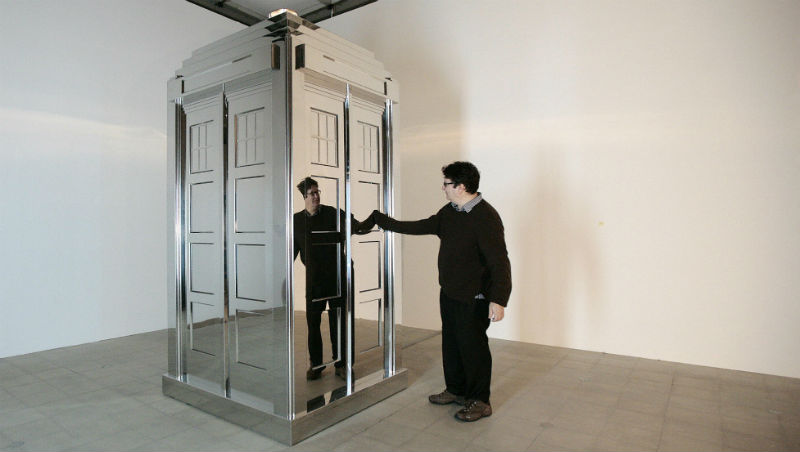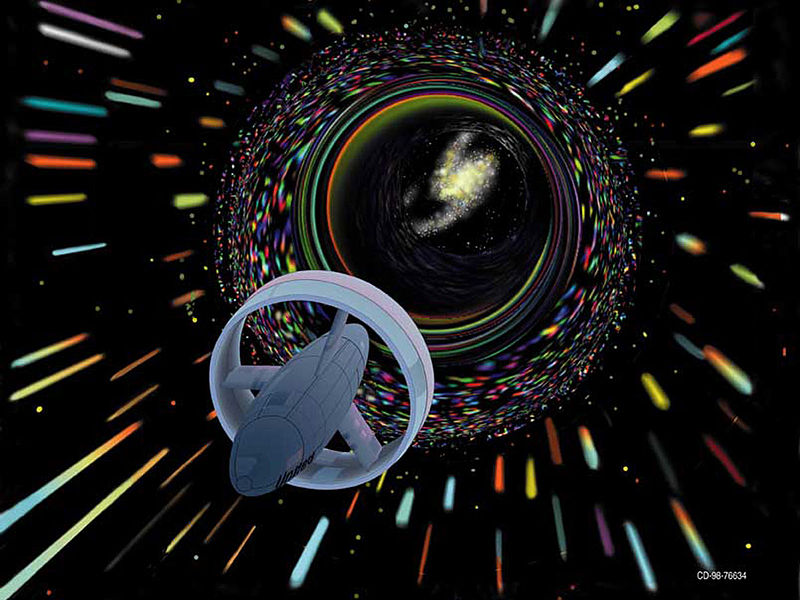Four ways in which time travel could be possible
Some physicists are convinced that time travel is possible. Here's how we might move through the fourth dimension

For as long as there has been science fiction, the concept of time travel has captured the imagination. Though it has long been dismissed as fantasy, physicists have not yet been able to prove or disprove that humans may one day be able to manipulate the fourth dimension.
"Time travel was once considered scientific heresy," writes Professor Stephen Hawking in the Daily Mail. "I used to avoid talking about it for fear of being labelled a crank." However, these days he's far less cautious, admitting he believes human will one day figure out how to travel into the future.
How could time travel be possible?
The Week
Escape your echo chamber. Get the facts behind the news, plus analysis from multiple perspectives.

Sign up for The Week's Free Newsletters
From our morning news briefing to a weekly Good News Newsletter, get the best of The Week delivered directly to your inbox.
From our morning news briefing to a weekly Good News Newsletter, get the best of The Week delivered directly to your inbox.
"The question of time travel features at the interface between two of our most successful yet incompatible physical theories," explains physicist Martin Ringbauer. "Einstein's general relativity and quantum mechanics." Using both of these theories, scientists have suggested several ways they believe time travel could be possible – at least theoretically. These include:
Wormholes

Einstein suggested the theoretical existence of "bridges" through time and space – often referred to as wormholes. His theory has been further developed by numerous physicists including Stephen Hawking and Kip Thorne.
A wormhole would allow an object to travel from one point to another faster than the speed of light, by taking a shortcut through space-time, meaning the object won't break the rule of the so-called universal speed limit — the speed of light — because it will at no point actually travel at a speed faster than light.
A free daily email with the biggest news stories of the day – and the best features from TheWeek.com
"The basic idea if you're very, very optimistic is that if you fiddle with the wormhole openings, you can make it not only a shortcut from a point in space to another point in space, but a shortcut from one moment in time to another moment in time," Professor Brian Greene, a prominent string-theory physicist, told Live Science.
Problem : No wormhole has ever been discovered, and even if it was, it would be far too small for scientists to manipulate for the purposes of time travel – measuring just a billion-trillion-trillionth of a centimetre across. They also pose a significant risk, bringing with them the threat of sudden collapse, high levels of radiation and contact with dangerous exotic matter, Space.com warns.
Wormholes are unstable because of the feedback created by this radiation, explains Hawking. In the same way that excessive feedback between a microphone and a speaker will fry the equipment, a wormhole is damaged by the radiation feedback it generates. "As soon as the wormhole expands, natural radiation will enter it, and end up in a loop," he explains. "So although tiny wormholes do exist, and it may be possible to inflate one someday, it won't last long enough to be of any use as a time machine."
Cosmic strings
Described as one-dimensional "cracks in the universe" and some of the strangest structures observed by cosmologists, cosmic strings could help us navigate through time. "Cosmic strings are either infinite or they're in loops, with no ends", explains J Richard Gott, an astrophysicist at Princeton University. "So they are either like spaghetti or Spaghetti Os."
They are thought to have formed billions of years ago, moments after the Big Bang, and because they contain such large amounts of mass, some scientists believe they could potentially "warp" space-time around them. "The approach of two such strings parallel to each other, will bend space-time so vigorously and in such a particular configuration that [it] might make time travel possible – in theory," according to Live Science.
Problem: Again, cosmic strings only exist only in theory. "This is a project a super civilisation might attempt," says Gott. "It's far beyond what we can do. We're a civilisation that's not even controlling the energy resources of our planet."
Furthermore, in order to travel back in time just twelve months, it would require a cosmic loop that contains half the mass of the entire universe, which we are unlikely to see any time soon.
Supermassive black hole
Described by Professor Hawking as natural time machines, black holes are so dense that they have a dramatic impact on time, slowing it down more than anything else in the universe. If a spaceship were to orbit a black hole, those on board would only experience eight minutes of time for every 16-minute orbit.
"Around and around they'd go, experiencing just half the time of everyone far away from the black hole. The ship and its crew would be travelling through time," he explains. "Imagine they circled the black hole for five years. Ten years would pass elsewhere. When they got home, everyone on Earth would have aged five years more that they had."
Problem: Black holes are more practical than wormholes because they don't present the same paradoxes and won't be destroyed by feedback. "But it's pretty dangerous," concedes Hawking. "It's a long way away and it doesn't even take us very far into the future.
Again, the crew of a ship circling a black hole would need to travel at around the speed of light in order for this plan to work. Physicist Amos Iron at the Technion-Israel Institute of Technology in Haifa, Israel told Space.com of another limitation if one used a machine: it might fall apart before being able to rotate that quickly.
Travelling at the speed of light
Another possibility would be travelling at the speed of light, a constant, finite speed of 186,000 miles per second. In Einstein's special theory of relativity, “time” as a universal concept. Instead, time passes differently for different observers, depending on the observers' motion and - more importantly, speed.
"If you go fast, your clock runs slow relative to people who are still," explains physicist Professor Brian Cox in the Daily Mail. "As you approach the speed of light, your clock runs so slow you could come back 10,000 years in the future."
Problem: According to the laws of physics, nothing can travel as fast as the speed of light – let alone a spaceship. Even the Large Hadron Collider, the strongest particle accelerator in the word, can't make protons move that fast. "If a proton did achieve that speed, it would need infinite energy to go any faster, and we don't have an infinite supply of energy," explains the BBC's Jennifer Ouellette. Also, the human body would not be able to withstand time travel at all, as travelling at nearly the speed of light would kill you.
This concept is known as time dilation.
Why time travel may be impossible by any means
Apart from physical problems, several paradoxes stand in the way of time travel. These include the "grandparent paradox", which has long flumoxed physicists and philosophers
As Science Alert explains, a time traveller could in theory prevent his or her grandparents from meeting, "thus preventing the time traveller's birth". This would make it impossible for the time traveller to have set out in the first place and kept the grandparents apart.
However, cosmologists believe they have figured a way around this by suggesting that there is more than one universe in existence – the 'multiverse' model. This allows for every possible version of an event to take place. The Independent's science editor Steve Connor gives this example: "a woman who goes back in time to murder her own granny can get away with it, because in the universe next door the granny lives to have the daughter who becomes the murderer's mother."
This, and other paradoxes, are situations that "give cosmologists nightmares," writes Hawking. But, "even if it turns out that time travel is impossible, it is important that we understand why it is impossible," he says.
-
 Why is Iran facing its biggest protests in years?
Why is Iran facing its biggest protests in years?TODAY’S BIG QUESTION Iranians are taking to the streets as a growing movement of civic unrest threatens a fragile stability
-
 How prediction markets have spread to politics
How prediction markets have spread to politicsThe explainer Everything’s a gamble
-
 Magazine printables - Dec. 19, 2025
Magazine printables - Dec. 19, 2025Puzzle and Quizzes Magazine printables - Dec. 19, 2025
-
 52 ideas that changed the world - 47. Relativity
52 ideas that changed the world - 47. RelativityIn Depth Einstein’s theory remains ‘most important in modern physics’
-
 What’s in Albert Einstein’s ‘God letter’?
What’s in Albert Einstein’s ‘God letter’?Speed Read Famous note penned by theoretical physicist goes up for auction today
-
 Schrodinger's cat explained
Schrodinger's cat explainedIn Depth The thought experiment lives on – or does it? What Schrodinger's cat tells us about quantum physics
-
 Ten Things You Need to Know Today: Friday 23 Sep 2011
Ten Things You Need to Know Today: Friday 23 Sep 2011Daily Briefing